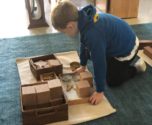
By Paige Edwards, AMI Primary Guide
I have a confession to make: I know better than to bring judgement into a mindfulness practice, but I nevertheless consider myself a pretty mediocre meditator. It is a practice that I have built into each day for a while now, and I still have frequent experiences of mentally drifting to lesson planning, grocery lists, and self-critiques before I can even count ten breaths in and out. But it is a practice that has still helped me immensely as a parent, an educator, and a citizen in this modern world. And research supports my experience: studies on mindfulness practice have shown that it reduces anxiety, decreases bias, potentially prevents and treats depression, increases body satisfaction, and improves cognition and focus (read more at 6 Scientifically Proven Benefits of Mindfulness and Meditation (Forbes.com)).
I imagine that there are varying levels of comfort and expertise with the word \’mindfulness\’ in our school community, and I recognize that it has become quite a buzzword in recent times. What do I mean by mindfulness, and what does it have to do with what we do here at Chesapeake Montessori School?
For the purposes of this article, I will defer to a few of the leading experts on the subject. Jon Kabat-Zinn says \”mindfulness means paying attention in a particular way: on purpose, in the present moment, and nonjudgmentally.\” Daniel J. Siegel adds that it includes \”being sensitive to novelty in our everyday experiences.\” Thich Nhat Hanh explains that \”mindfulness shows us what is happening in our bodies, our emotions, our minds, and in the world.\”
As someone who spends a lot of time with young children, it strikes me that this presence in the moment, this awareness of novelty, and this experiencing without judging (without putting \”shoulds\” on one\’s experience) is a lot like how young children experience the world. Young children move at a different pace than adults, as evidenced each day when I try to leave the house with my children. They experience things fully, and they become fascinated with a small insect or rock that we never even noticed.



And while young children might not have some of the qualities of adult mindfulness (meta-awareness or a sustained meditation practice) I believe that there is a profound potential in young children to cultivate mindfulness. This has powerful long-term implications for these children and the world they will create. Dr. Montessori had early insight, over 100 years ago, into the potential of children to be mindful. And it is clear to me that our work in Montessori classrooms is closely aligned with this approach.
Montessori Values a Child\’s Concentration
A cardinal rule in Montessori training is to create an environment that fosters concentration and to protect concentration when it happens. Dr. Montessori wrote, \”the first essential for the child\’s development is concentration. The child who concentrates is immensely happy.\” She recognized the positive benefits of focused attention: on learning, emotional regulation, social development, and well-being.
Researchers often compare attention to a muscle; the more you \”exercise\” it, the stronger it becomes. Some are now making similar comparisons to strengthening your \”compassion muscle.\” A study by Microsoft Corp., described in a TIME article titled \”You Now Have An Attention Span Shorter Than a Goldfish,\” found that from the year 2000 to 2015, an average adult\’s attention span dropped from 12 seconds to 8 seconds. While there is surely controversy over the exact cause(s) (could it be screens?, information overload?, not enough time in nature?, etc.), I think we all feel the frustration of our attention being \”highjacked.\” What impact does constant interruption have on children and their developing brains?
The Montessori Primary classroom has a three-hour morning work period to allow uninterrupted concentration and \”flow,\” a psychological concept named by Mihaly Csikszentmihalyi to describe a highly focused mental state. Recent research supports the idea that this uninterrupted work period has a positive impact. A study in Milwaukee Public Schools followed children randomly assigned to public Montessori schools and showed that these children had better executive functioning than children who did not go to a Montessori school in that school district, controlling for other factors. And a study with Montessori middle schoolers show that they report \”feeling significantly greater affect, potency, intrinsic motivation, flow experience, and undivided interest\” than conventional middle school students. Read more about these studies in this book.
Conventional schooling does not typically have large blocks of uninterrupted time. \”Our K-12 system largely still adheres to the century-old, industrial-age factory model of education.\” This is a direct quote from the previous Secretary of Education, Arne Duncan. The old factory model aimed to fill students\’ brains with knowledge and skills within strictly managed time periods dedicated to different subjects, managed by teachers, and efficiently resulting in replicable \”products\” (i.e. graduates). For a thorough discussion of the fundamental flaws of this approach and the science supporting Montessori, read this book by Dr. Angeline Lillard, a professor at the University of Virginia.)
If children were given an educational environment to freely develop their concentration on activities of interest and challenge, to strengthen their attention \”muscles,\” how might they more fully reach their potentials? William James, the \”Father of American Psychology,\” stated in his 1890 Principles of Psychology, that \”The faculty of voluntarily bringing back a wandering attention over and over again is the very root of judgment, character and will… An education which should improve this faculty would be the education par excellence.\” Montessori education has this intention at its core.
Montessori Creates a Culture of Grace, Courtesy, Compassion, and Kindness
Richard Davidson, acclaimed neuroscientist at the University of Wisconsin, states, \”we become what we practice.\” In our classrooms, we practice daily being kind members of a community. And we do this quite intentionally. Lessons in \”Grace and Courtesy\” are at the heart of our primary Montessori classroom\’s culture. Through modeling and role-playing, we aim to proactively equip children with the language and skills needed to navigate social situations with compassion and confidence.
Montessori and Mindfulness Practices
There are several practices in a Primary Montessori environment that directly aim to cultivate the regulation of attention. One example is the Silence Game. This is a whole-group activity where all the children work together to create silence. This is quite a feat of self-control for a young three-year old. Walking on the Line is another activity in which a child practices slowly and attentively walking around a marked ellipse, often times with the whole class. A child may choose to challenge himself by practicing heel-toe walking or by balancing an object on her head. If you were to observe in my class, this activity is not likely to look like a walking meditation, but Dr. Montessori did design this activity as a way to further develop a child\’s self-regulation.
Montessori Teacher Training
One of the major components of Montessori training is practicing how to observe children. Surely, this is used to assess academic skills and knowledge, but it is more importantly a tool to non-judgmentally notice children\’s choices and behaviors, to decipher their needs and interests, and to notice obstacles to their development.
In addition, we are trained to \”get out of the way\” during important times. If we notice a child is concentrating or persisting to figure something out on her own, we typically do not intervene. And we have a classroom full of didactic materials which give the child feedback, so that we are not constantly correcting the child. This helps create a culture of non-judgment in the classroom and encourages the child to become more independent and intrinsically motivated.
Finally, as adults in the classroom, we try (to the very best of our adult abilities) to stay attentive, graceful, and compassionate in their presence. Because they do as we do, not as we say. Don\’t we, as parents, know this well!
As I confessed earlier, I am a humble practitioner of mindfulness. But I am inspired each day by the potential Montessori has to develop these inherent qualities in our children. It is fulfilling work to create an environment here at CMS where the children can grow to move through this world with more presence of mind, character, and well-being.
Additional Resources
In addition to the embedded articles and videos, here are a few other resources in you are looking for more:






